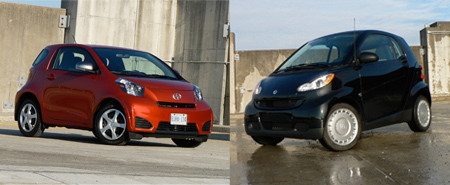Comparo: 2012 Scion iQ vs. Smart ForTwo
Story and photos by John LeBlanc
More and more Canadians are deciding to live in cities. For drivers, that lifestyle decision includes a heavy diet of traffic congestion, tight parking spots, and stop-and-go traffic. So while the majority of new car buyers still buy “normal” size vehicles — those categorized as “compact” and up — a growing number of both city dwellers and commuters are seeing the less-is-more value of tiny, so-called city cars.
To date, those customers only had the Smart ForTwo, the diminutive two-seater Mercedes-Benz Canada’s been selling here since 2004. But Toyota Canada’s Scion brand recently launched its ForTwo-inspired 2012 iQ. So which one is the better city car?
SECOND PLACE: 2012 Smart ForTwo Coupe Pure
Small cars should come with small prices. And with a starting MSRP of $14,400, the ForTwo scores an early victory over the $16,760 iQ. And with a four-year/80 km warranty, the Smart offers 12 more months/20 km more than the Scion. It only takes a few blocks of urban driving, though, to see where the Scion makes up the difference in value.
Overall, there’s less room in the ForTwo than the iQ. But if you can make do with the Smart’s seats for two, its split-level tailgate is more practical than the Scion’s conventional one-piece lift gate. It allows for small bags to be dropped in via the top glass hatch, or longer objects can be laid on the bottom fold-out gate. At least the quality of its plastics and tight fitment of its interior bits gives the Smart a more premium feel than the Scion.
Rated the same on the highway at 4.7 L/100 km, the Scion and Smart are also neck-and-neck in city ratings: 5.5 and 5.8, respectively. But real-world figures are much different. I recorded 6.5L/100 km overall in the Smart and an unspectacular 9.8L in the Scion. With only three cylinders making 70 horsepower and 68 pound-feet of torque, the rear-engine, rear-wheel-drive, Smart is outgunned by the relatively more powerful front-engine, front-wheel-drive Scion, which arrives with one more cylinder, 94 hp and 89 lb.-ft.
Just don’t expect any kind of fast and furious performance from either. The Scion takes almost 14 seconds to get to highway speeds. By all accounts, that’s slow. But it’s about one second quicker than the snail-like Smart.
Whether driving on highways or downtown streets, the ForTwo feels a lot less refined than the iQ. Compared to the iQ’s continuously variable transmission, the ForTwo’s sequential autobox (you tap the lever to change gears up or down) remains a sore point. Smooth shifts require playing with the throttle to avoid head-jerking changes. The ForTwo’s ride is much harsher as well, with plenty of wind noise at anything over 90 km/h. And when it comes to on- and off-ramps, the Scion feels more planted than the taller-riding ForTwo.
An all-new ForTwo is expected some time next year. And it may address the shortcomings of the current car, which essentially was designed in the 1990s. Until then, the current Smart’s compromises seem to outweigh its advantages. It delivers excellent fuel economy, a tiny footprint, a luxury-brand warranty and a low price.
FIRST PLACE: 2012 Scion iQ
One look at the iQ and it’s apparent Toyota designed the Scion for customers looking for a better Smart ForTwo. And, unequivocally, the Japanese automaker has accomplished its goal. Just like the ForTwo, the iQ was created to take up as little space as possible on crowded city streets.
The tiny Toyota shares similar proportions with the Mercedes minicar. But the Scion is dimensionally larger, inside and out. Toyota engineers cleverly reorganized the iQ’s front dash components, carving out more room just ahead of the front passenger. This trick not only delivers an airier experience for those sitting up front, but also allows the passenger seat to slide forward enough to allow the occasional passenger to ride in the back for short distances. Admittedly, there’s only enough room behind the iQ’s pair of rear seats for a briefcase. But when folded, they free up a decent amount of cargo room.
The iQ is no sports compact. But with a longer wheelbase and wider track than the Smart, the Scion is more composed on the move, whether it’s trying to look for a parking spot or on a long drive to a friend’s cottage for the weekend. In town, the Scion’s turning circle is actually smaller than the Smart. In the Scion, larger cornering manoeuvres result in minimal body roll and predictable (i.e. safe) understeer when pushed hard. Its ride won’t beat you up as much as the ForTwo either. And where the Smart steering is vague, the Scion’s helm delivers decent feel and weight.
Too bad the iQ is saddled with the mandatory CVT transmission. The rubber band box is smoother than the Smart’s gearbox (which is not staying much). But it saps the life out of the Scion’s hard working four-banger. In Europe, where’s it’s sold as a Toyota (and as the Aston Martin Cygnet), the iQ can be had with a manual gearbox. I would petition Toyota Canada to offer that choice to Canadians.
Sucking CVT or not, in the end, Toyota has designed a smarter ForTwo with its iQ. There’s more room overall (even for a pair of small and/or flexible rear passengers), and offers a much more agreeable, day-to-day driving experience.






![[del.icio.us]](https://www.straight-six.com/wp-content/plugins/bookmarkify/delicious.png)
![[Digg]](https://www.straight-six.com/wp-content/plugins/bookmarkify/digg.png)
![[Facebook]](https://www.straight-six.com/wp-content/plugins/bookmarkify/facebook.png)
![[Google]](https://www.straight-six.com/wp-content/plugins/bookmarkify/google.png)
![[Reddit]](https://www.straight-six.com/wp-content/plugins/bookmarkify/reddit.png)
![[StumbleUpon]](https://www.straight-six.com/wp-content/plugins/bookmarkify/stumbleupon.png)
![[Twitter]](https://www.straight-six.com/wp-content/plugins/bookmarkify/twitter.png)
![[Email]](https://www.straight-six.com/wp-content/plugins/bookmarkify/email.png)